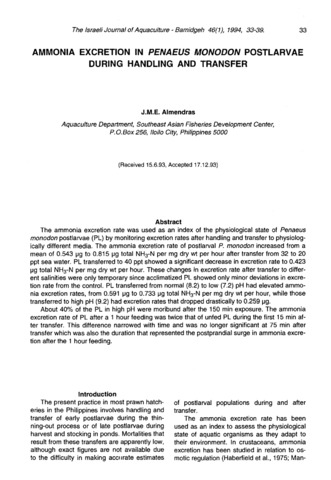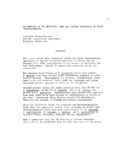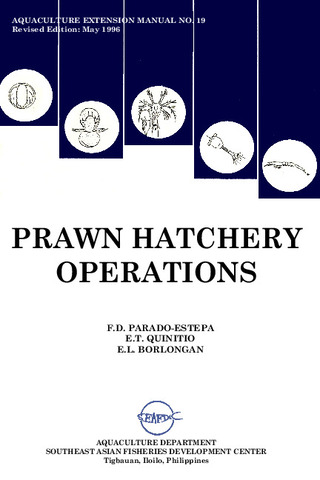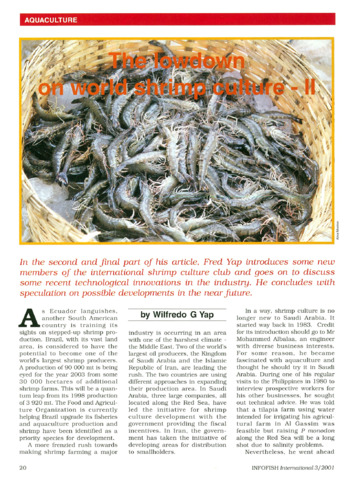Ammonia excretion in Penaeus monodon postlarvae during handling and transfer
- Global styles
- MLA
- Vancouver
- Elsevier - Harvard
- APA
- Help

View/
Date
1994Author
Page views
1,668ASFA keyword
AGROVOC keyword
Taxonomic term
Metadata
Show full item record
Share
Abstract
The ammonia excretion rate was used as an index of the physiological state of Penaeus monodon poltlarvae (PL) by monitoring excretion rates after handling and transfer to physiologically different media. The ammonia excretion rate of postlarval P. monodon increased from a mean of 0.543 µg to 0.815 µg total NH3-N per mg dry wt per hour after transfer from 32 to 20 ppt sea water. PL transferred to 40 ppt showed a significant decrease in excretion rate to 0.423 µg total NH3-N per mg dry wt per hour. These changes in excretion rate after transfer to different salinities were only temporary since acclimatized PL showed only minor deviations in excretion rate from the control. PL transferred from normal (8.2) to low (7.2) pH had elevated ammonia excretion rates, from 0.591 µg to 0.733 µg total NH3-N per mg dry wt per hour, while those transferred to high pH (9.2) had excretion rates that dropped drastically to 0.259 µg.
About 40% of the PL in high pH were moribund after the 150 min exposure. The ammonia excretion rate of PL after a 1 hour feeding was twice that of unfed PL during the first 15 min after transfer. This difference narrowed with time and was no longer significant at 75 min after transfer which also the duration that represented the postprandial surge in ammonia excretion after the 1 hour feeding.
Suggested Citation
Almendras, J. M. E. (1994). Ammonia excretion in Penaeus monodon postlarvae during handling and transfer. The Israeli Journal of Aquaculture-Bamidgeh , 46(1), 33-39. http://hdl.handle.net/10862/1440
Type
ArticleISSN
0792-156XCollections
- Journal Articles [1258]
Related items
Showing items related by title, author, creator and subject.
-
An overview of the nutrition, feed and feeding techniques of prawn penaeid/shrimps
Piedad-Pascual, Felicitas (Philippine Council for Aquatic and Marine Research and Development, 1989)This paper echoes what transpired during the first International Conference of Penaeid Prawns/Shrimps held in Iloilo City in December 4-7, 1984, particularly on the Nutrition nd Feed Development. Around 25 papers were ... -
Series: Aquaculture extension manual; No. 19
Prawn hatchery operations
Parado-Estepa, Fe D.; Quinitio, Emilia T. ; Borlongan, Emeterio L. (Aquaculture Department, Southeast Asian Fisheries Development Center, 1996-05)
The manual, an updated version of the 1984 SEAFDEC/AQD manual, presents the underlying principles and step-by-step instructions of prawn larval and post-larval rearing. The techniques described are not only applicable to ...
; Borlongan, Emeterio L. (Aquaculture Department, Southeast Asian Fisheries Development Center, 1996-05)
The manual, an updated version of the 1984 SEAFDEC/AQD manual, presents the underlying principles and step-by-step instructions of prawn larval and post-larval rearing. The techniques described are not only applicable to ... -
The lowdown on world shrimp culture - II
Yap, Wilfredo G. (INFOFISH, 2001)This paper introduces some new members of the international shrimp culture club and goes on to discuss some recent technological innovations in the industry, particularly the polyculture of tilapia (mainly Oreochromis ...





